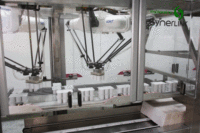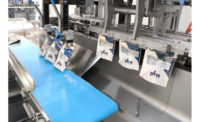Behind many of the most well-known private label brands of cheese and cheese products sold in North American supermarkets is one of the continent’s largest cheese maturation and cheese converting processors. Supplying more than 250 million pounds of cheese annually to grocery chains, wholesalers, restaurants and distributors, Plymouth, Wis. -based Masters Gallery Foods maintains one of the largest privately held cheese inventories in the United States.
The company's extensive product line includes American favorites such as mild and aged cheddars, combination cheeses such as colby jack and Monterey Jack with peppers; Italian stretched-curd cheeses such as mozzarella and provolone; hard-grating Parmesan, Romano and Asiago cheeses, specialty cheeses such as brie, Gouda and Swiss; and processed cheeses blended to deliver a consistent texture and flavor. These cheeses come from cheese producers and arrive in bulk at Masters Gallery Foods' facilities, where they are aged in six temperature-controlled warehouse and then converted, cut, packaged and shipped throughout North America.
Although each cheese ages, shreds and cuts differently, only premier cheeses leave the company's facilities.
"Our passion is for quality cheese," says Mark Wirtz, engineering manager at Masters Gallery Foods. "This starts with assuring quality, consistency and reliability of our cheese suppliers. Each and every vat of cheese that comes through our doors is personally tasted, smelled and tested by one of our 14 licensed cheese graders to ensure it has the compositional and sensory attributes to meet the highest standards.
“Our processes ensure that quality cheeses and custom blends will meet our customers’ needs,” he adds. “That means only the exact age, body, flavor, color and performance of cheese will be cleared for release to our customers."
Product diversity
For retail markets, Masters Gallery Foods produces hundreds of cheese products in the form of slices, bars, shreds, chunks and sticks, which it packages in pouches, loaves and tubs. For foodservice, 5- and 10-pound packages of shreds, dices, cubes, slices and loaves are prepared. To service its industrial customers, the company provides 6-pound, 40-pound and 640-pound cheese blocks under its in-house Wisconsin Premium brand.
Multiple storage facilities allow Masters Gallery Foods to house extensive inventories of cheese, helping its customers manage risk, hedge the dairy market, maintain fixed pricing and procure just-in-time inventories.
"We have built our market share over the past 46 years on preparing customized cheese products for our customers," adds Wirtz. "Many times, they will provide the cheese and want it converted into a different product, a unique shred or cut, or unique packaging that has never been tried before. For customers looking for a certain taste of cheese, we will work with our cheese producers to come up with a blend that works for them."
Flexible robotics support
Managing this volume and diversity of product requires highly specialized automation able to adapt flexibly to changes in product runs.
"To support this market need for customized product, we have to push our automation as far as we can, and make it do things that it was not designed to do," continues Wirtz. "We are always redesigning our machinery. Our automated systems from the onset are very unique and originally built so they can be modified with minimal difficulty."
This is particularly important with the company's end-of-line packaging systems, where maintaining consistently high throughput is critical to keeping upstream processes moving. Each of the company's six maturation facilities employs sophisticated robotics for both case packing and palletizing.
Designed by Quest Industrial — a Monroe, Wis.-based manufacturer of industrial automation equipment — these robotic systems are unique in their capability for precision gripping and placement at high speeds, as well as their flexibility to adapt in real time to changes in product mix.
"Quest understands our challenges," explains Wirtz. "The company has been building robotics systems for our end-of-line packaging for the past 10 years — specifically, robotic case packers and robotic palletizers. These are highly customized systems built to our requirements, but with tremendous flexibility to accommodate our need for modification of the equipment in house."
Robotic case packers
Master’s Gallery Foods uses Quest’s Quik Pick QP200 in its plant. The Quik Pick system is a high-speed robotic case packer that is quick, accurate and compact.
“Essentially, the robot picks up an item from an accumulation conveyor and places it into a case,” explains Wirtz. “An example of one of our applications [is] the robot needs to be capable of picking up super small cheese items that weigh less than 1 ounce, and then pick up a package that is bulky and weighs 2 pounds. This level of flexibility is what is needed for our case packing processes."
A main differentiating point of the Quik Pick system is its flexibility. Through its touchscreen HMI and custom software, it can be configured for product in-feed rates from 20 to more than 400 pieces per minute.
"This robotic case packer accepts a wide range of product types, sizes and textures," says Aaron Philips, vice president of automation at Quest. "It provides flexible options for custom orientation of cheese product, such as pile stacks, base stacks, random cuts, shingle stacks, two-three stacks and twin stacks."
According to Philips, the system can handle weights ranging from a ½ ounce to 20 pounds.
"Supporting quality inspection, it provides automated visual inspection and product weight verification for the many different cheese products running through the lines at the Masters Gallery Foods' facilities," he adds.
Simplifying robotic palletizing
Masters Gallery Foods has nine robotic palletizers in operation within its six maturation facilities. These are used for end-of-line finished palletizing of cases before stretch wrapping and movement into chilled storage. All of these palletizers were developed by Quest working directly with the engineering team at Masters Gallery Foods. Three of these Boxed-Bot robotic palletizers were just recently installed at the company's new plant, a section of which was designed based on the Toyota Production System (TPS).
"We are going into the initial phases of kicking off our own operational excellence plan, which we call the Island of Excellence, modeled off of the TPS," adds Wirtz. "This new plant produces various products of sliced cheeses. We have installed three Quest Boxed-Bot robotic palletizers that have unique capabilities which support our Island of Excellence plan."
One of those features is an over/under capability for movement of pallets within the palletizing cell. A forklift sets a pallet on the infeed conveyor that moves it in toward the robot. The pallet is elevated about 18 inches once the palletizing is done, then the completed pallet is ejected back over the top of the conveyor to the start of the infeed for pick up with a forklift. With palletizer speeds of over 30 cycles per minute, this permits the forklift operator to wait for palletization to be completed without having to make a return trip.
Another feature is the integration of a custom-designed foam gripper, utilizing a foam pad to compensate for top-of-case irregularities. Traditional robotic suction cups have limitations on how many cups can actually be secured to the top of a box. When moving at high velocity, the case can become distorted, or if the suction cups happen to fall on a case seam or distorted flap, the vacuum seal can be broken, and the box can be sent flying. The foam pad eliminates these issues.
"Without the foam gripper, it would limit the products that the palletizer actually can run," continues Wirtz. "Some of the cases would need to be hand stacked by manual labor. The foam gripper makes for a more reliable pick. This reduced the mis-picks and the slowdowns on the line caused by them."
The robotic palletizers installed at Masters Gallery Foods give operators more functionality to design and produce exact robotic palletizing patterns for variations of packaging with different product types. One function allows for on-the-fly changes to box and package sizes and patterns, permitting easy changeovers from product to product without the need for reprogramming. Behind this functionality is Quest's QBox robotic palletizing software.
The software makes it easy to drag and drop to change box or packaging patterns (such as chimney, interlock and uniform patterns) and sizes; select, rotate or flip layers; change box length, width and height; adjust pallet sizes or types; account for label-out or label-in orientations; and rotate box/packaging. And custom edge detection allows for maximum stacking efficiency.
"Palletizing operators at Masters Gallery Foods can easily create new patterns using the HMI touch screen," adds Philips. "Intuitive screens perform all machine set-up, product changeover and diagnostic functions. The HMI screen is designed for simple yet comprehensive access to all aspects of the palletizer functionality, including automatic and custom manual operations, pattern selection and programming, back-up, recovery operations, safety status and maintenance logs. For an operator not experienced in robotics programming, to create a new palletizing program and modify it as needed on the fly is a considerable advantage for our operations."
Flexibility, efficiency
By integrating versatile and intuitive robotic case packing and palletizing, Masters Gallery Foods has enabled a new level of flexibility and efficiency throughout its maturation plants.
"This has enabled more options for customized case and pallet configurations, faster changeovers for different packaging runs and reduced downtime, with more consistent end-of-line throughput," says Wirtz. "It is helping us move closer towards achieving our Island of Excellence goals."


